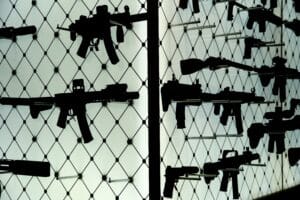Illinois may have just increased the odds the Supreme Court takes up an “assault weapons” ban case sooner than later.
Predicting when the Supreme Court will grant certiorari is generally a fool’s errand, as most petitions for review are ultimately denied. When it comes to appeals from preliminary injunction rulings especially, the high court tends to be loath to get involved because it prefers to wait for final judgments and circuit splits. Those are the tough circumstances facing the several Second Amendment-related cert petitions currently pending before the Court, and no one should be surprised if all are ultimately denied until they come back up with final judgments.
However, some recent arguments raised in the legal fight over an Illinois AR-15 ban may tempt the Court to intervene. This week, the State of Illinois filed its brief in opposition to the several pending cert petitions seeking to reverse the Seventh Circuit’s ruling in Bevis v. City of Naperville. In it, Illinois made several arguments the majority of the Court might feel the need to rebut.
The first is the embrace of the purported new Bruen “two-step test” many courts have adopted. Under this reading of Bruen, the burden is first on plaintiffs challenging a law to show the Second Amendment is implicated before the all-important historical analysis even occurs. This approach is erroneous because Bruen clearly calls for a one-step test. Surely, the Court did not intend to replace the two step, tiers-of-scrutiny analysis it explicitly rejected with yet another two-step test. As the Court said, “[d]espite the popularity of th[e] two-step approach, it is one step too many.”
To be sure, for there to be a viable Second Amendment challenge, the right to keep and bear arms must at least be implicated. Just as a First Amendment free speech case must involve speech, so too must a Second Amendment case involve the peaceable use or ownership of arms. But this should be no more than a simple qualifier, not an independent “step” requiring in-depth analysis.
The second argument that may invite early Supreme Court scrutiny is closely related to the first: Illinois’ contention that the Seventh Circuit was correct in concluding that so-called “assault weapons” are not even “arms” protected by the Second Amendment. Following that circuit court’s logic, Illinois argues that the Second Amendment was never intended to protect weapons that are “exclusively or predominantly used by the military.” Because rifles like the AR-15 are similar to M-16s, Illinois argues, they are too much like military firearms to earn any Second Amendment protection.
This argument may be troubling to the Supreme Court because it ignores that Heller defined what “arms” are in the Second Amendment context using 18th-century dictionaries, including one that explained that “arms” are “any thing that a man wears for his defence, or takes into his hands, or useth in wrath to cast at or strike another.” Bruen reaffirmed that this includes all “modern instruments that facilitate armed self-defense, even those that were not in existence at the time of the founding.” Heller also rejected any attempts by the government to second guess what Americans choose to use for self-defense when it explained that “[w]hatever the reason, handguns are the most popular weapon chosen by Americans for self-defense in the home, and a complete prohibition of their use is invalid.”
But even if the banned firearms are “arms” under the plain text of the Second Amendment, Illinois argues they may still be restricted because there is a tradition of “reserving some [firearms], if appropriate, to the military or law enforcement.” If the Supreme Court is truly as focused on a historical test as it said it was in Bruen, then this argument alone warrants immediate intervention to correct the Seventh Circuit.
In truth, there is not and has never been a rule that arms may be banned just because they may also be used by the military. The supposed “distinction between military and civilian weaponry” the Seventh Circuit insisted on is a fabrication. As Judge Michael B. Brennan pointed out in his dissent, the military uses many firearms that are also commonly used by civilians, making the majority’s ruling nonsensical in practice.
“Under the majority opinion, the military’s decision to award Beretta a military contract for the Beretta 92 would take the firearm out of the ‘Arms’ protected by the Second Amendment,” he wrote.
If there is one thing that the founders and the first few generations of Americans after them were abundantly clear on, it is that the Second Amendment exists in large part as a guard against tyranny, regardless of whether such tyranny comes from a foreign invader or the government itself. Tench Coxe, a delegate to the Constitutional Convention, wrote that “[w]hereas civil rulers, not having their duty to the people duly before them, may attempt to tyrannize, … the people are confirmed by the article in their right to keep and bear their private arms.” And the Second Amendment’s original meaning was not understood any differently in the 19th century.
Indeed, many commentators singled out the “arms of modern warfare” as what the Second Amendment protected most of all. Writing in 1868, John Norton Pomeroy explained that “a militia would be useless unless the citizens were enabled to exercise themselves in the use of warlike weapons.” Similarly, Henry Campbell Black wrote in 1895 that “[t]he citizen has at all times the right to keep arms of modern warfare.”
Dozens of other examples abound, and many of them are covered in my recent law review article on this very topic. There isn’t a historical tradition of barring common arms just because they may be useful in combat when one of the main purposes of the Second Amendment was to be, as one judge put it, a “doomsday provision” for the people to protect themselves from tyranny.
None of this is to say that weapons used by the military which are shown to be “dangerous and unusual” can never be restricted. As District Judge Roger Benitez explained in his Duncan ruling addressing California’s magazine capacity law, history and tradition might support restricting weapons “useful solely for military purposes.” But the firearms banned by Illinois are not surface-to-air missile systems or warheads; they are some of the most popular and common firearms in the country.
Finally, at least some Justices may take issue with Illinois’ and the Seventh Circuit’s argument that the popularity of the banned firearms is not enough to grant them any protection. This appears to be in direct contradiction to what Justice Alito said in his concurring opinion in Caetano, where he noted that stun guns were protected in part because hundreds of thousands (but not millions) of Americans owned them. Here, the situation is far more clear cut, because tens of millions of Americans own firearms that Illinois has banned. Several estimates put the number of AR-15s alone at over 20 million. Illinois has questioned numbers coming from Georgetown University Professor William English and the National Shooting Sports Foundation. But a Washington Post survey has also found about 1 in 20 Americans own an AR-15, or roughly 16.5 million people. Whatever the “floor” is for commonality, estimates from a range of sources make it clear that the AR-15 certainly meets it.
So, the Court may be moved to accept the case at this early stage after reading Illinois’ brief. Or it could opt to grant, vacate, and remand the Seventh Circuit’s opinion with instructions on how to properly go about the Bruen analysis. This would temporarily save the Court from having to decide such a high-profile issue for the time being, while still helping to correct the errant circuit. Of course, the Supreme Court may also be content to take a more traditional path by waiting to grant review on an “assault weapons” ban case until after one has reached final judgment.
Whatever it actually decides to do, Illinois’s making these arguments probably increases the odds that the Court will act soon.
NOTE: Kostas Moros is an attorney who is working on Federal Firearms Licensees of Illinois v. Pritzker, which is also challenging the Illinois ban. However, the arguments in this article are his alone and are not made on behalf of any clients, other petitioners, or the law firm where he works.






